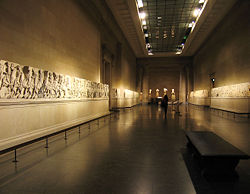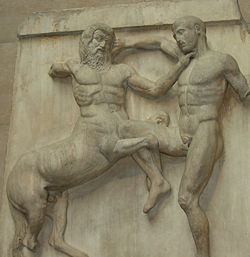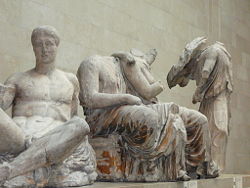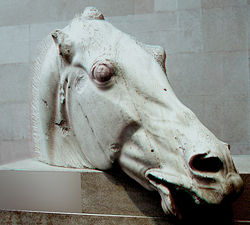Difference between revisions of "Elgin Marbles" - New World Encyclopedia
(started) |
|||
| Line 3: | Line 3: | ||
[[Category:Anthropology]] | [[Category:Anthropology]] | ||
| − | |||
| − | |||
| − | |||
[[Image:Elgin Marbles British Museum.jpg|thumb|right|250px|General view of the room displaying the Elgin Marbles.]] | [[Image:Elgin Marbles British Museum.jpg|thumb|right|250px|General view of the room displaying the Elgin Marbles.]] | ||
| − | |||
| − | |||
The '''Elgin Marbles''' ([[International Phonetic Alphabet|IPA]]: /{{IPA|'ɛl gən}}/), also known as the '''Parthenon Marbles''' or '''Parthenon Sculptures''', are a large collection of [[marble sculpture]]s removed from [[Athens]] to [[United Kingdom|Britain]] in 1806 by [[Thomas Bruce, 7th Earl of Elgin]], ambassador to the [[Ottoman Empire]] from 1799 to 1803. Taking advantage of Ottoman occupation over [[Greece]], he obtained a ''[[firman]]'' for their removal from the [[Parthenon]] from the Ottoman [[Sultan]]. The sculptures were deposited in the [[British Museum]], [[London]] in 1816, and in 1936 were placed into the purpose-built Duveen Gallery. | The '''Elgin Marbles''' ([[International Phonetic Alphabet|IPA]]: /{{IPA|'ɛl gən}}/), also known as the '''Parthenon Marbles''' or '''Parthenon Sculptures''', are a large collection of [[marble sculpture]]s removed from [[Athens]] to [[United Kingdom|Britain]] in 1806 by [[Thomas Bruce, 7th Earl of Elgin]], ambassador to the [[Ottoman Empire]] from 1799 to 1803. Taking advantage of Ottoman occupation over [[Greece]], he obtained a ''[[firman]]'' for their removal from the [[Parthenon]] from the Ottoman [[Sultan]]. The sculptures were deposited in the [[British Museum]], [[London]] in 1816, and in 1936 were placed into the purpose-built Duveen Gallery. | ||
| Line 17: | Line 12: | ||
==Interpretation of the frieze== | ==Interpretation of the frieze== | ||
At present, about two-thirds of the frieze is in London and a third remains in Athens. Much of the Athenian material is not on display, and there are fragments in nine other international museums. Considerable debate surrounds the meaning of the frieze but most agree that it depicts the [[Panathenaic Games|Panathenaic]] procession that paraded from [[Eleusinian Mysteries|Eleusis]] to Athens every four years. The procession on the frieze culminates at the east end of the Parthenon in a depiction of the [[Greek gods]] who are seated mainly on stools, either side of temple servants in their midst. This section of the frieze is currently under-appreciated as it is split between London and Athens. A doorway in the British Museum marks the absence of the relevant section of Frieze. An almost complete copy of this section of the Frieze is displayed and open to the public at [[Hammerwood Park]] near [[East Grinstead]] in [[Sussex]]. | At present, about two-thirds of the frieze is in London and a third remains in Athens. Much of the Athenian material is not on display, and there are fragments in nine other international museums. Considerable debate surrounds the meaning of the frieze but most agree that it depicts the [[Panathenaic Games|Panathenaic]] procession that paraded from [[Eleusinian Mysteries|Eleusis]] to Athens every four years. The procession on the frieze culminates at the east end of the Parthenon in a depiction of the [[Greek gods]] who are seated mainly on stools, either side of temple servants in their midst. This section of the frieze is currently under-appreciated as it is split between London and Athens. A doorway in the British Museum marks the absence of the relevant section of Frieze. An almost complete copy of this section of the Frieze is displayed and open to the public at [[Hammerwood Park]] near [[East Grinstead]] in [[Sussex]]. | ||
| − | + | [[image:ac-marbles.jpg|thumb|250px|Metope from the Elgin marbles depicting a Centaur and a Lapith fighting.]] | |
==Criticism by Elgin's contemporaries== | ==Criticism by Elgin's contemporaries== | ||
When the marbles were shipped to Britain, there was criticism of Elgin (who had spent a fortune on the project) but also much admiration of the sculptures. [[Lord Byron]] strongly objected to their removal from [[Greece]]: | When the marbles were shipped to Britain, there was criticism of Elgin (who had spent a fortune on the project) but also much admiration of the sculptures. [[Lord Byron]] strongly objected to their removal from [[Greece]]: | ||
| Line 37: | Line 32: | ||
[[John Keats]] was one of those who saw them privately exhibited in London, hence his two [[sonnet]]s about the marbles. Some scholars, notably [[Richard Payne Knight]], insisted that the marbles dated from the period of the [[Roman Empire]], but most accepted that they were authentic works from the studio of [[Phidias]], the most famous ancient Greek sculptor. They were eventually purchased by Parliament for the nation in 1816 for £35,000 and deposited in the [[British Museum]], where they were displayed in the Elgin Saloon (constructed in 1832), until the Duveen Gallery was completed in 1939. | [[John Keats]] was one of those who saw them privately exhibited in London, hence his two [[sonnet]]s about the marbles. Some scholars, notably [[Richard Payne Knight]], insisted that the marbles dated from the period of the [[Roman Empire]], but most accepted that they were authentic works from the studio of [[Phidias]], the most famous ancient Greek sculptor. They were eventually purchased by Parliament for the nation in 1816 for £35,000 and deposited in the [[British Museum]], where they were displayed in the Elgin Saloon (constructed in 1832), until the Duveen Gallery was completed in 1939. | ||
| − | + | [[Image:Parthenon_pediment_statues.jpg|thumb|250px|right|Statuary from the east [[pediment]].]] | |
==Damage to the Marbles== | ==Damage to the Marbles== | ||
To facilitate transport, the column capital of the [[Parthenon]] and many metopes and slabs were sawn and sliced into smaller sections. One shipload of marbles on board the British brig ''Mentor'' was caught in a storm off [[Cape Matapan]] and sank near [[Kythera]], but was salvaged at the Earl's personal expense; it took two years to bring them to the surface.<ref name="TheParthenon">{{cite web | url=http://www.museum-security.org/The%20Parthenon%20and%20the%20Elgin%20Marbles.htm | title=The Parthenon and the Elgin Marbles | author=Vranopoulos, Epaminondas}}</ref> | To facilitate transport, the column capital of the [[Parthenon]] and many metopes and slabs were sawn and sliced into smaller sections. One shipload of marbles on board the British brig ''Mentor'' was caught in a storm off [[Cape Matapan]] and sank near [[Kythera]], but was salvaged at the Earl's personal expense; it took two years to bring them to the surface.<ref name="TheParthenon">{{cite web | url=http://www.museum-security.org/The%20Parthenon%20and%20the%20Elgin%20Marbles.htm | title=The Parthenon and the Elgin Marbles | author=Vranopoulos, Epaminondas}}</ref> | ||
| Line 52: | Line 47: | ||
==The British Museum position== | ==The British Museum position== | ||
A range of slightly different points have been put by [[British Museum]] spokespersons over the years in defence of retention of the Elgin Marbles within the museum. The main points include the maintenance of a single worldwide-oriented cultural collection, all viewable in one location, thereby serving as a world heritage centre; the saving of the marbles from what would have been, or would be, pollution and other damage if relocated back to Athens; and a legal position that the museum is banned by charter from returning any part of its collection.<ref>[http://www.thebritishmuseum.ac.uk/explore/highlights/article_index/e/the_elgin_marbles_ownership.aspx British Museum press release on the Elgin Marbles]</ref> The latter was tested in the British High Court in May 2005 in relation to Nazi-looted Old Master artworks held at the museum; it was ruled that these could not be returned.<ref>[http://www.guardian.co.uk/parthenon/article/0,,1494099,00.html Guardian article on legal ruling affecting the marbles' return policy, May 27, 2005]</ref> The judge, Sir Andrew Morritt, ruled that the British Museum Act – which protects the collections for posterity – cannot be overridden by a "moral obligation" to return works known to have been plundered. It has been argued however, that connections between the legal ruling and the Elgin Marbles were more tenuous than implied by the Attorney General.<ref>[http://www.elginism.com/20050603/126/ Article on the relevance of the Feldmann paintings judgment to the Elgin Marbles.]</ref> | A range of slightly different points have been put by [[British Museum]] spokespersons over the years in defence of retention of the Elgin Marbles within the museum. The main points include the maintenance of a single worldwide-oriented cultural collection, all viewable in one location, thereby serving as a world heritage centre; the saving of the marbles from what would have been, or would be, pollution and other damage if relocated back to Athens; and a legal position that the museum is banned by charter from returning any part of its collection.<ref>[http://www.thebritishmuseum.ac.uk/explore/highlights/article_index/e/the_elgin_marbles_ownership.aspx British Museum press release on the Elgin Marbles]</ref> The latter was tested in the British High Court in May 2005 in relation to Nazi-looted Old Master artworks held at the museum; it was ruled that these could not be returned.<ref>[http://www.guardian.co.uk/parthenon/article/0,,1494099,00.html Guardian article on legal ruling affecting the marbles' return policy, May 27, 2005]</ref> The judge, Sir Andrew Morritt, ruled that the British Museum Act – which protects the collections for posterity – cannot be overridden by a "moral obligation" to return works known to have been plundered. It has been argued however, that connections between the legal ruling and the Elgin Marbles were more tenuous than implied by the Attorney General.<ref>[http://www.elginism.com/20050603/126/ Article on the relevance of the Feldmann paintings judgment to the Elgin Marbles.]</ref> | ||
| + | [[Image:Elgin horse 2d.jpg|thumb|250px|right|Parthenon Selene Horse. ([[:Image:Elgin horse 3d.jpg|3d alt]])]] | ||
==Other displaced Parthenon art== | ==Other displaced Parthenon art== | ||
Revision as of 17:21, 3 September 2007
The Elgin Marbles (IPA: /'ɛl gən/), also known as the Parthenon Marbles or Parthenon Sculptures, are a large collection of marble sculptures removed from Athens to Britain in 1806 by Thomas Bruce, 7th Earl of Elgin, ambassador to the Ottoman Empire from 1799 to 1803. Taking advantage of Ottoman occupation over Greece, he obtained a firman for their removal from the Parthenon from the Ottoman Sultan. The sculptures were deposited in the British Museum, London in 1816, and in 1936 were placed into the purpose-built Duveen Gallery.
Description
The Elgin Marbles include some of the statuary from the pediments, the metope panels depicting battles between the Lapiths and the Centaurs, as well as the Parthenon Frieze which decorated the horizontal course set above the interior architrave of the temple. As such, they represent more than half of what now remains of the surviving sculptural decoration of the Parthenon: the Elgin marbles and frieze extend to about 1km when laid out flat, 15 out of 92 metopes; 17 partial figures from the pediments, as well as other pieces of architecture. Elgin's acquisitions also included objects from other buildings on the Athenian Acropolis: the Erechtheion, reduced to ruin during the Greek War of Independence (1821–33); the Propylaia, and the Temple of Athena Nike. Lord Elgin took half of the marbles from the Parthenon and jwax casts were produced from the remaining ones.
Interpretation of the frieze
At present, about two-thirds of the frieze is in London and a third remains in Athens. Much of the Athenian material is not on display, and there are fragments in nine other international museums. Considerable debate surrounds the meaning of the frieze but most agree that it depicts the Panathenaic procession that paraded from Eleusis to Athens every four years. The procession on the frieze culminates at the east end of the Parthenon in a depiction of the Greek gods who are seated mainly on stools, either side of temple servants in their midst. This section of the frieze is currently under-appreciated as it is split between London and Athens. A doorway in the British Museum marks the absence of the relevant section of Frieze. An almost complete copy of this section of the Frieze is displayed and open to the public at Hammerwood Park near East Grinstead in Sussex.
Criticism by Elgin's contemporaries
When the marbles were shipped to Britain, there was criticism of Elgin (who had spent a fortune on the project) but also much admiration of the sculptures. Lord Byron strongly objected to their removal from Greece:
- Dull is the eye that will not weep to see
- Thy walls defaced, thy mouldering shrines removed
- By British hands, which it had best behoved
- To guard those relics ne’er to be restored.
- Curst be the hour when from their isle they roved,
- And once again thy hapless bosom gored,
- And snatch'd thy shrinking gods to northern climes abhorred!
- —"Childe Harold's Pilgrimage"
Byron was not the only Englishman to protest the removal at the time:
- "The Honourable Lord has taken advantage of the most unjustifiable means and has committed the most flagrant pillages. It was, it seems, fatal that a representative of our country loot those objects that the Turks and other barbarians had considered sacred,"
said Sir John Newport.
A contemporary MP Thomas Hughes, an eye witness, later wrote:
- "The abduction of small parts of the Parthenon, of a value relatively small but which previously contributed to the solidity of the building, left that glorious edifice exposed to premature ruin and degradation. The abduction dislodged from their original positions, wherefrom they precisely drew their interest and beauty, many pieces which are altogether unnecessary to the country that now owns them."
John Keats was one of those who saw them privately exhibited in London, hence his two sonnets about the marbles. Some scholars, notably Richard Payne Knight, insisted that the marbles dated from the period of the Roman Empire, but most accepted that they were authentic works from the studio of Phidias, the most famous ancient Greek sculptor. They were eventually purchased by Parliament for the nation in 1816 for £35,000 and deposited in the British Museum, where they were displayed in the Elgin Saloon (constructed in 1832), until the Duveen Gallery was completed in 1939.
Damage to the Marbles
To facilitate transport, the column capital of the Parthenon and many metopes and slabs were sawn and sliced into smaller sections. One shipload of marbles on board the British brig Mentor was caught in a storm off Cape Matapan and sank near Kythera, but was salvaged at the Earl's personal expense; it took two years to bring them to the surface.[1]
While the artifacts were held in London, unlike those remaining on the Parthenon, have been saved from the hazards of pollution, neglect, and war, they have also been irrevocably damaged by the unauthorized "cleaning" methods employed by British Museum staff in the 1930s, who were dismissed when this was discovered. Acting under the erroneous belief that the marbles were originally bright white, the marbles were cleaned with copper tools and caustics, causing serious damage and altering the marbles' colouring. (The Pentelicon marble on which the carvings were made naturally acquires a tan colour similar to honey when exposed to air.) In addition, the process scraped away all traces of surface colouring that the marbles originally held, but more regretably, the detailed tone of many carvings were lost forever. The British Museum held an internal enquiry and the officers responsible ceased museum employment. However, this controversy began with the press picking up rumours of such abrasive cleaning, and the extent of any possible damage soon became exaggerated in heated controversy.[2]
According to a list of facts revealed by appeals to the UK Freedom of Information Act, the Elgin Marbles were damaged by two schoolboys fighting in the British Museum in 1961. One of the boys fell and knocked off part of a centaur's leg.[3]
The Greek claim to the Marbles
The Greek government claims that the marbles should be returned to Athens on moral grounds, although it is no longer feasible or advisable to reposition them onto the Parthenon. As part of the campaign, it is building the New Acropolis Museum, designed by the Swiss-American architect Bernard Tschumi, designed to hold the Parthenon sculptures arranged in the same way as they would have been on the Parthenon. It is intended to leave the spaces for the Elgin Marbles empty, rather than using casts in these positions, as a reminder to visitors of the fact that parts are held in other museums. The new museum plan also attracted controversy; the construction site contains late Roman and early Christian archaeology, including an unusual seventh-century Byzantine bath house and other finds from Late Antiquity. A court challenge in Greece from the International Council on Museums and Sites (ICOMOS) to the site was rejected by the Greek civil courts in 2004. The new design incorporates the archaeological finds within the building.[4]
The British Museum position
A range of slightly different points have been put by British Museum spokespersons over the years in defence of retention of the Elgin Marbles within the museum. The main points include the maintenance of a single worldwide-oriented cultural collection, all viewable in one location, thereby serving as a world heritage centre; the saving of the marbles from what would have been, or would be, pollution and other damage if relocated back to Athens; and a legal position that the museum is banned by charter from returning any part of its collection.[5] The latter was tested in the British High Court in May 2005 in relation to Nazi-looted Old Master artworks held at the museum; it was ruled that these could not be returned.[6] The judge, Sir Andrew Morritt, ruled that the British Museum Act – which protects the collections for posterity – cannot be overridden by a "moral obligation" to return works known to have been plundered. It has been argued however, that connections between the legal ruling and the Elgin Marbles were more tenuous than implied by the Attorney General.[7]
Other displaced Parthenon art
Lord Elgin was neither the first, nor the last, to disperse elements of the marbles from their original location. The remainder of the surviving sculptures that are not in museums or storerooms in Athens are held in museums in various locations across Europe. The British Museum also holds additional fragments from the Parthenon sculptures acquired from various collections that have no connection with Lord Elgin.
Material from the Parthenon was dispersed both before and after Elgin's activities. The British Museum holds approximately half of the surviving sculptures. The remainder is divided among the following locations:
- Extensive remains of the metopes (especially east, north and west), frieze (especially west) and pediments
- Less than 50% is on public display and some is still on the building.
- One frieze slab
- One metope
- Fragments of the frieze and metopes
- A head from the pediments
- National Museum of Denmark, Copenhagen:
- Two heads from a metope in the British Museum
- University of Würzburg, Würzburg:
- Head from a metope in the British Museum
- Museo Salinas, Palermo:
- Fragment of frieze
- Vatican Museums:
- Fragments of metopes, frieze and pediments
- Kunsthistorisches Museum, Vienna:
- Three fragments of frieze
- Glyptothek, Munich:
- Fragments of metopes and frieze; not on display
The collection held in the British Museum includes the following material from the Acropolis:
- Parthenon: 247ft of the original 524ft of frieze
- 15 of the 92 metopes
- 17 pedimental figures; various pieces of architecture
- Erechtheion: a Caryatid, a column and other architectural members
- Propylaia: Architectural members
- Temple of Athena Nike: 4 slabs of the frieze and architectural members
Further reading
- Mary Beard, The Parthenon (Profile Books, 2004) ISBN 978-1861973016
- Christopher Hitchens, The Elgin Marbles: Should they be returned to Greece? (with essays by Robert Browning and Graham Binns) (Verso, March 1998)
- Ian Jenkins, The Parthenon Frieze (British Museum Press, 2002)
- Dorothy King, The Elgin Marbles (Hutchinson, January 2006)
- William St. Clair, Lord Elgin and the Marbles (Oxford University Press, 1998)
ReferencesISBN links support NWE through referral fees
- ↑ Vranopoulos, Epaminondas. The Parthenon and the Elgin Marbles.
- ↑ BM article and Ian Jenkins, "Cleaning and Controversy," 2001
- ↑ 2007-03-5, "59 things that would have stayed secret", Times Online
- ↑ Archaeology Magazine article on the Acropolis Museum controversies, July/August 2004.
- ↑ British Museum press release on the Elgin Marbles
- ↑ Guardian article on legal ruling affecting the marbles' return policy, May 27, 2005
- ↑ Article on the relevance of the Feldmann paintings judgment to the Elgin Marbles.
External links
Campaigning websites
- The Restitution of the Parthenon Marbles
- Dorothy King on why the Elgin Marbles should stay in London
- Acropolis of Athens — AcropolisofAthens.gr — one monument, one heritage
- British Committee for the Reunification of the Parthenon Marbles' site
- Marbles Reunited: Friends of the British Committee for the Reunification of the Parthenon Marbles
- The International Association for the Reunification of the Parthenon Sculptures
- Elginism — Collection of news articles relating to the Elgin Marbles
- An interpretation of the meaning of the Marbles
- A guide to the case for the restitution of the Parthenon Marbles
- Gillen Wood, "The strange case of Lord Elgin's nose": the cultural context of the early 19th century debate over the marbles, the politics and the esthetics, imperialism and hellenism
- Information about arguments for the marbles to be returned to Greece
- Marbles with an Attitude — a different approach to the cause of reuniting the Parthenon Marbles
- BBC News — Swede gives back Acropolis marble
- Demand for the return of Elgin Marbles
Credits
New World Encyclopedia writers and editors rewrote and completed the Wikipedia article in accordance with New World Encyclopedia standards. This article abides by terms of the Creative Commons CC-by-sa 3.0 License (CC-by-sa), which may be used and disseminated with proper attribution. Credit is due under the terms of this license that can reference both the New World Encyclopedia contributors and the selfless volunteer contributors of the Wikimedia Foundation. To cite this article click here for a list of acceptable citing formats.The history of earlier contributions by wikipedians is accessible to researchers here:
The history of this article since it was imported to New World Encyclopedia:
Note: Some restrictions may apply to use of individual images which are separately licensed.




